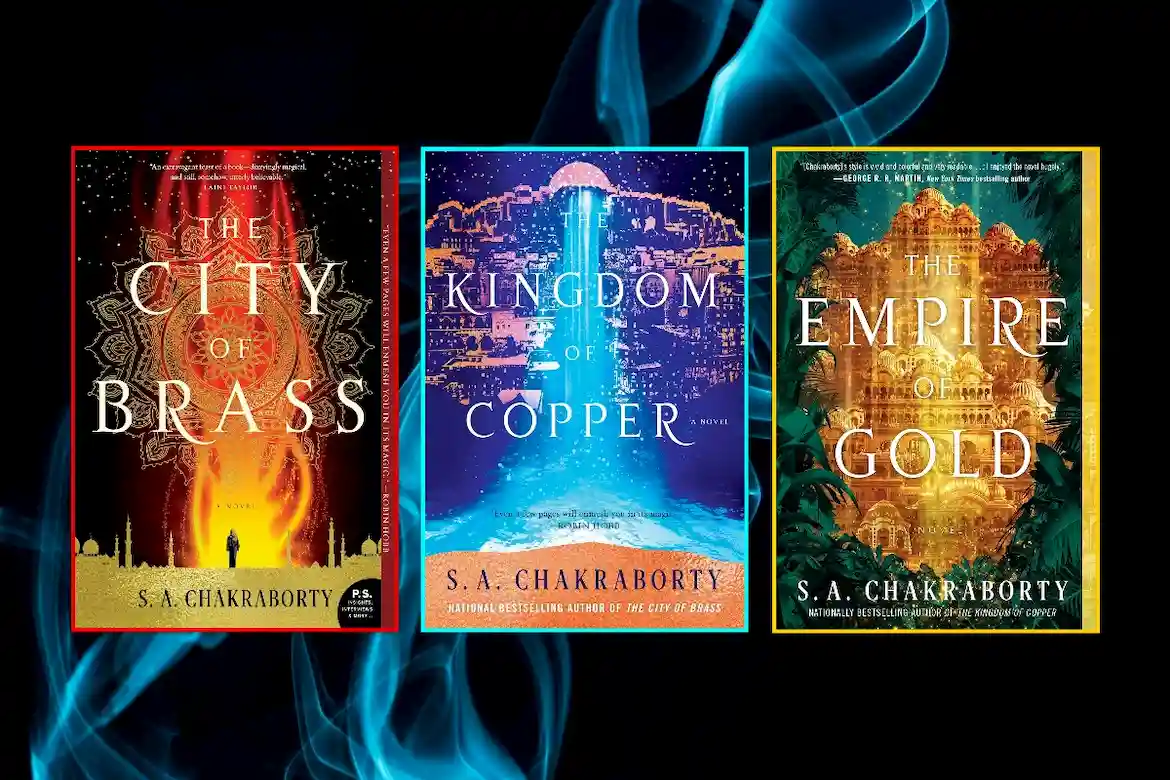This week’s LitStack Recs says yes to The Daevabad Trilogy by S. A. Chakraborty. We think it’s a must read.
You can find and buy the books we recommend on our Bookshop LitStack Recs.

In This LitStack Rec of The Daevabad Trilogy
Is The Daevabad Trilogy the Next Great Epic Fantasy Masterpiece?
LitStackers, do you find yourself searching for the next great epic fantasy trilogy? I know I do. I had hoped that S. A. Chakraborty’s Daevabad Trilogy would be that masterpiece epic trilogy, it is so very close, definitely a strong contender. We loved the books, they’re this week’s LitStack Recs. I would say, S.A. Chakraborty’s Daevabad Trilogy are not her masterpiece. But they’re must reads. The books augur well for the author’s future works and our future reads.

A Very Respectable Place in Second
The Daevabad Trilogy wins on detail alone. It is a massive amount of detail. It is stuffed to the brim with details of history, of factions, of characters and actions. If you are detail-oriented in any way, you will adore this trilogy. The trilogy is an incredible achievement and is truly a worthwhile read. There is no doubting the breadth and depth of Chakraborty’s world, nor the amount of work that happens in these pages. This is immense. So immense it seems overweight with detail.
Yet the beauty of the books themselves. The jewel colors, the impressionistic art on the covers. The depth of these books, their page counts, their weights. It feels epic to hold each of the three books as you read them. The books bring the prize home in detail, they fulfill all the exciting wonderful trappings we expect from the genre.
This is a Love Triangle
Though here, in the characters’ love triangle, there’s a filter between the characters and the reader. We somehow, with all the chipping and building and rendering that occurs, we somehow as readers don’t quite get to be underneath the skin of these characters. Something about this writing is keeping us from that intimate experience. Why? On purpose or through error?
There’s a point of view issue, I believe. There’s a filter there, that unnamed, unwelcome being telling the reader what the character feels. I didn’t find myself invited to infer the emotions of the characters. I think if I had been more drawn into that relationship, that exchange, by the author’s use of a closer point of view, then I would have said, yes, this is a masterpiece. A writer needs to know to let down their guard in point of view. Always give consideration to point of view distance. If the scenes and narrative of this trilogy had allowed this reader to participate in the miracle exchange that occurs from a close point of view, I would have said yes, this is a masterpiece.
The Daevabad Trilogy Did Rescue Me
I have to tell you one reason I love these books. The Daevabad Trilogy rescued me. It brought me out of a reading drought, caused by grief. The death of two family members in a short amount of time. For eight months I didn’t read. Then I read Daevabad and haven’t stopped reading since.
This isn’t just a series—it’s an adventure that transports you to a Middle Eastern (I’d thought Mesopotamium) era. The trilogy—comprising The City of Brass, The Kingdom of Copper, and The Empire of Gold— draws you into its magical world that is rooted in Middle Eastern mythology.
Imagine djinn, legendary feuds, lots of smoke, and unforgettable characters. The setting—a mythical version of the 18th-century Middle East—color, spice, energy, and authenticity, shaping every move forward in the plot and every nuance of the story’s conflicts. Place is used beautifully in these novels. But it could be more of a reflection of the character’s interior. Regardless, the setting is breathtaking, fantastical and yet remarkably real, especially as the narrative delves into themes like tribalism and religious strife.
I entered Daevabad, and didn’t want to depart. Let’s explore a bit about every book—and what was remarkable in this fantasy epic The Daevabad Trilogy.
Book One: The City of Brass
Where Magic Finds a Con Woman


It is 18th-century Cairo. Here, we encounter Nahri, a savvy orphan who survives by conning nobles with palmistry and clever ruses. She possesses a talent for healing but brushes it aside as merely another facet of her cunning and deception. Then, one day, amid what appears to be a standard (con) exorcism, Nahri inadvertently calls forth Dara, a formidable, ancient djinn warrior with a shadowy history. Instantly, the enchanted realm Nahri believed was merely a myth becomes chillingly tangible. A lot of scary people and creatures are chasing Dara and, consequentially, Nahri.
With Cairo no longer a safe place for Nahri and Dara, they embark on a perilous journey across the desert to Daevabad, the legendary city of brass, the heart of the magical world. This journey is a slow burn, giving you plenty of time to soak in the world-building and get acquainted with the djinn and their complex history. Once in Daevabad, Nahri is thrown into ancient political games and simmering tribal hatreds. Here, she meets and becomes good friends with Prince Alizayd al-Qahtani, or Ali, a devout and compassionate prince who champions the rights of the shafit (half-human, half-djinn)–who are treated as second-class citizens. The long romance begins (and it takes a while, almost the entire trilogy, for even a kiss).
Nahri quickly realizes she is the final heir of the deposed Nahid royal lineage, which once governed Daevabad prior to the rise of the Qahtani dynasty. She’s a healer. She grapples with her deepening, complex emotions for Dara and a fragile but significant friendship with Ali. The city is rife with tribal strife and an escalating rebellion, placing Nahri in the middle of an impending civil conflict. The story escalates to a dramatic conclusion, resulting in turmoil across Daevabad and Dara appearing to have vanished.
The world-building in The City of Brass is exceptional. It’s lush and elaborate, you become immersed in its complex social hierarchies, political conflicts, and enchanting features. As is usual, there’s a glossary to assist you in keeping up with all the captivating names and clans. Sometimes in epic fantasy a glossary is nice to have, like icing on a cake. Here, it is essential. If you don’t consult the glossary here, there’s a good chance you’ll miss a lot of what is being talked about. It’s a bit of a trudge to need to consult the glossary over and over while reading Daevabad. But, that’s what we’re in for here, a long haul.
Book Two: The Kingdom of Copper
Exile, Evolution, and Escalation


In The Kingdom of Copper, some time after the events of The City of Brass, Nahri finds herself ensnared in a tumultuous political union in Daevabad, while Ali, in exile, is uncovering new abilities. Dara, brought back to life and tethered to Nahri’s wrathful mother, Manizheh, grapples with his allegiances as the city spirals deeper into financial turmoil and tribal discord, compelling all three to face their histories and navigate tough decisions. This time jump is brilliant, allowing you to see how trauma and consequences have truly shaped the characters.
Nahri is now married to Ali’s brother, Emir Muntadhir, a purely political union that leaves her trapped. Despite the restrictions, she dedicates herself to rebuilding the city’s hospital, becoming the incredibly skilled healer her genetics promise: the Banu Nahida.
Ali, exiled and facing assassination attempts, has found refuge in a remote desert village. Here, he’s discovered mysterious water abilities, a consequence of an earlier encounter with a marid. This period of exile transforms him, making him less naive and more reflective, channeling his understanding of Daevabad’s systemic issues into plans for real change.
And Dara? Believed dead, he’s resurrected by Nahri’s mother, Manizheh, the leader of the Nahid rebellion. Now bound to Manizheh, Dara is forced to serve her “bloody and dangerous mandate,” training her forces. He’s constantly battling internal conflict, questioning if Manizheh’s increasingly ruthless methods are truly justified. His very presence still strikes fear into the hearts of many due to his violent past.
Daevabad itself is in a dire state, plagued by economic issues, violence, and unrest, with tribal tensions at an all-time high. King Ghassan resorts to increasingly brutal tactics to maintain control, only worsening the prejudice against the shafit. Ali is eventually drawn back into Daevabad’s dangerous politics, setting the stage for an even more intense showdown.
This book truly excels at showing the profound impact of war and oppression on individuals, as Nahri, Ali, and Dara grapple with their evolving identities and loyalties. And for those who love a good slow-burn romance, Nahri and Ali’s relationship continues to develop with incredible care and nuance (very slowly). They don’t kiss in the second novel either. On the plus side, there is Muntadhir’s secret love affair with Jamshid which adds a poignant layer of queer representation. Turns out, aside from Nahri’s one hookup with Dari, these books are the Muntadhir and Jamshid show, as far as the sex goes, but even with the queer relationship mentioned, there is a noticeable lack of sexual intimacy in these novels.
Book Three: The Empire of Gold
The Epic Conclusion


The trilogy culminates in The Empire of Gold, bringing all the threads together for its finale. After Daevabad’s devastating fall (Manizheh’s conquest of Daevabad), Nahri and Ali escape to Cairo, carrying Suleiman’s Seal. Here, they discover shocking revelations about their histories and abilities. At the same time, Dara struggles with the increasing brutality of Manizheh. Ultimately, the trio must return to a magic-depleted Daevabad for an epic showdown that will shape the city’s destiny and force them to confront the enduring cycle of revenge. This temporary peace–a long portion of the book where everyone’s magic has been cancelled, yes cancelled because Suleman’s Seal has been taken out of Daevabad–allows the narrative to uncover all the shocking truths about Nahri’s past and Ali’s powerful connection to the marid.
Back in Daevabad, Dara is forced to confront the horrific atrocities Manizheh has commanded. He tries to broker peace, but blood magic compels him to serve as Manizheh’s attack dog. A pivotal moment for Dara is his realization that he no longer wants to be the terrifying afshin, a mere weapon. A massive war for Daevabad becomes inevitable, promising irreversible changes for the city. The story focuses on the ultimate confrontation, deciding the city’s fate.
This final book is a powerful journey of self-actualization for our main characters. They truly come into their own, defining their identities beyond their past traumas. Nahri fully embraces her destiny as Banu Nahida, finding her true place and family. She transforms into a formidable leader, ready to face her monstrous mother. Ali’s journey of understanding the world’s complexities continues, moving beyond simple black-and-white morality. He delves deeper into his marid heritage, demonstrating incredible strength and making a crucial, irreversible sacrifice that ultimately saves Daevabad.
And yes, his slow burn romance with Nahri finally culminates but not with any trace of sex, they share a relationship built on deep respect, friendship, and equality. As for Dara, he transitions from an enslaved warrior to a figure grappling with profound betrayal and renewed enslavement, and a desperate search for identity beyond his violent past. He confronts ugly truths about his history and puts himself at the mercy of those he once considered enemies. The ending, while not a perfect happily ever after, is full of hope for Daevabad and its people, suggesting that the cycle of vengeance can finally be broken.
The Reasons We Love The Daevabad Trilogy

A World You Can Get Lost In
The world-building. Absolutely stunning! Forget your typical medieval European settings; Chakraborty transports you to a vibrant, 18th-century mythical Middle East, brimming with djinn lore and Islamic traditions. It’s refreshingly different and yet authentic–a delicate balance–with every custom, piece of architecture, and even the food and weaponry deeply rooted in its unique culture. The world feels both magical and somewhat grounded in humanity. You’ll appreciate how meticulously the history of the djinn world is built, explaining how centuries of conflict led to its current, tense state. And you’ll need to consult the glossary, often.
Characters You Want to Know Better
Nahri, Ali, and Dara are well developed and nuanced characters.They endure quite a bit throughout the series. Their long arcs hold up well over the three books. They endure the profound impacts of war, violence, and oppression. There are three alternating points of view, Nehri, Dara, and Ali, giving readers an intimate look into the minds of the main characters of this love triangle.
One of the things I loved about the characters was that they had flaws, the antagonists were humanized without being excused.
All in all, I wish I could know these characters better. I was not for some reason allowed to participate in the characters emotionally. I was not invited to infer the emotions of the characters. There was a filter in the point of view that kept me from participating in the character-reader exchange. Something keeps readers at an arm’s length, rather than letting us in, to underneath the skin, the muscle, into the marrow.
More Than Magic: Edgy Themes, Palace Intrigue, Fantasy Tropes
This trilogy isn’t afraid to tackle its themes of prejudice, inequality, and tribalism, especially concerning the shafit, who face severe discrimination. It draws powerful parallels to real-world issues, showing the relentless cycle of vengeance that arises from such conflicts. Ali’s unwavering commitment to social justice for everyone, regardless of tribe, is truly inspiring.
The fictional conflicts of djinn tribalism and bigotry are explicitly presented as reflections of our own reality, and beg the question who is the enemy. This series uses its fantasy setting to explore profound sociopolitical issues like minority oppression and the manipulation of power, making it incredibly relevant and thought-provoking.
If you love a good political thriller, The Daevabad Trilogy is packed with palace politics, warring factions, family secrets and complex court politics, balancing political intrigue and magical elements, fire and water and earth and air.
One of the most refreshing aspects is the focus on healing magic and medicine, with Nahri learning to master her innate healing powers alongside human medical methods. Plus, the use of three distinct points of view (Nahri, Ali, Dara) was a smart writer’s choice and is well done (with some provisions as above) adding depth and giving you what is inside the characters’ heads.

Our Final Recommendation
You’ve Got to be Strong and Diligent, as with any grand epic. Yes, read it. Of course, read it!
S. A. Chakraborty’s The Daevabad Trilogy is a masterclass in world-building, character development, scene development and thematic depth, offering a refreshing and authentic fantasy experience unlike other trilogies. We’re bought into Nahri’s journey, Ali’s unwavering ideals, and Dara’s tragic quest for redemption. The intricate relationships, the gripping political intrigue, and the powerful exploration of real-world issues through a fantastical lens make this trilogy an absolute must-read. We can’t wait to read more Chakraborty.
If you’re looking to fulfill your next epic fantasy obsession, pick up all three books of The Daevabad Trilogy today.
They definitely worked for me.
~ J.S. Hood
About S. A. Chakraborty
Shannon Chakraborty is the critically acclaimed, New York Times bestselling author of The Daevabad Trilogy and The Adventures of Amina al-Sirafi. Her work has been translated into over a dozen languages and nominated for the Hugo, Locus, World Fantasy, Crawford, and Astounding awards.
You can connect with S. A. Chakraborty on her website, and on Instagram.
Other LitStack Resources
Be sure and look at our other LitStack Recs for our recommendations on books you should read, as well as our LitStack Reviews by Lauren Alwan, Rylie Fong, Allie Coker, Lewis Buzbee, Jess Reincke, and Sharon Browning.
As a Bookshop, Malaprop’s, BAM, Barnes & Noble, Audiobooks.com, Amazon, and Envato affiliate, LitStack may earn a commission at no cost to you when you purchase products through our affiliate links.






